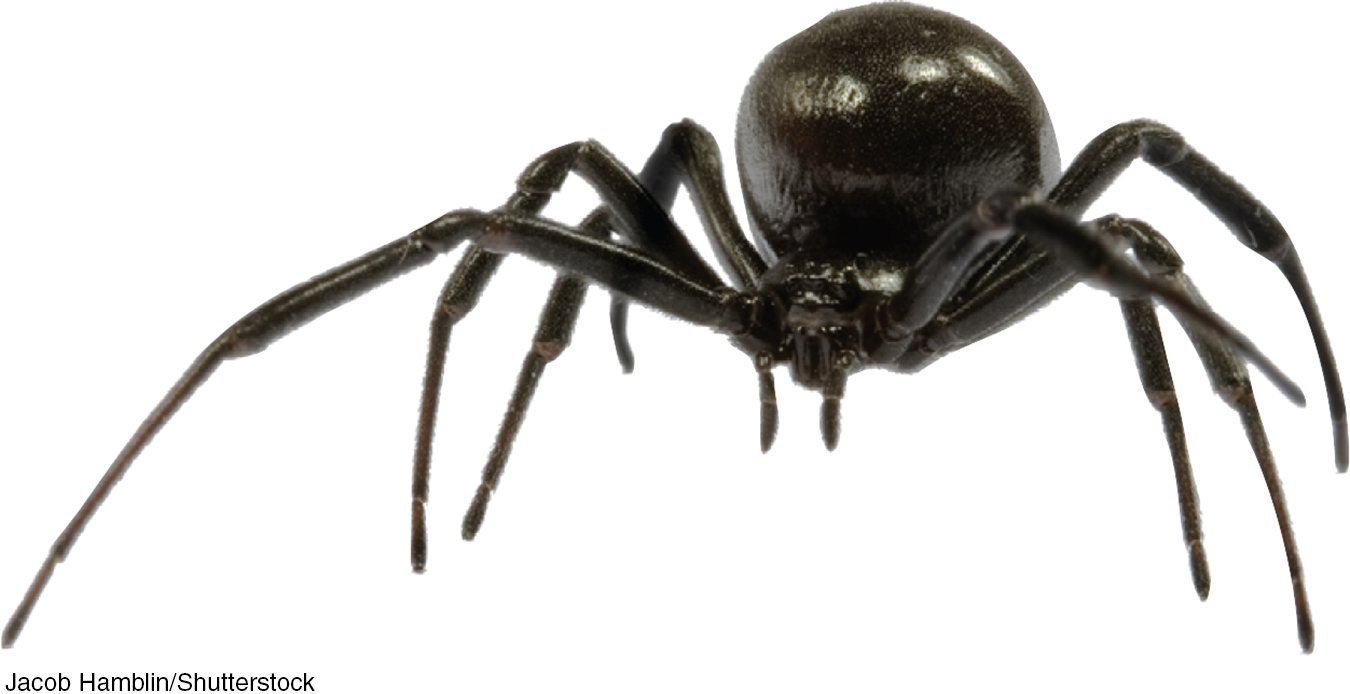6.2 Evolutionary Psychology: Understanding Human Nature
6-
evolutionary psychology the study of the evolution of behavior and the mind, using principles of natural selection.
natural selection the principle that those chance inherited traits that better enable an organism to survive and reproduce in a particular environment will most likely be passed on to succeeding generations.
Behavior geneticists explore the genetic and environmental roots of human differences. Evolutionary psychologists instead focus mostly on what makes us so much alike as humans. They use Charles Darwin’s principle of natural selection to understand the roots of behavior and mental processes. The idea, simplified, is this:
Organisms’ varied offspring compete for survival.
Certain biological and behavioral variations increase organisms’ reproductive and survival chances in their particular environment.
Offspring that survive are more likely to pass their genes to ensuing generations.
Thus, over time, population characteristics may change.
To see these principles at work, let’s consider a straightforward example in foxes.
Natural Selection and Adaptation
A fox is a wild and wary animal. If you capture a fox and try to befriend it, be careful. Stick your hand in the cage and, if the timid fox cannot flee, it may snack on your fingers. Russian scientist Dmitry Belyaev wondered how our human ancestors had domesticated dogs from their equally wild wolf forebears. Might he, within a comparatively short stretch of time, accomplish a similar feat by transforming the fearful fox into a friendly fox?
To find out, Belyaev set to work with 30 male and 100 female foxes. From their offspring he selected and mated the tamest 5 percent of males and 20 percent of females. (He measured tameness by the foxes’ responses to attempts to feed, handle, and stroke them.) Over more than 30 generations of foxes, Belyaev and his successor, Lyudmila Trut, repeated that simple procedure. Forty years and 45,000 foxes later, they had a new breed of foxes that, in Trut’s (1999) words, were “docile, eager to please, and unmistakably domesticated. . . . Before our eyes, ‘the Beast’ has turned into ‘beauty,’ as the aggressive behavior of our herd’s wild [ancestors] entirely disappeared.” So friendly and eager for human contact were these animals, so inclined to whimper to attract attention and to lick people like affectionate dogs, that the cash-

Over time, traits that give an individual or species a reproductive advantage are selected and will prevail. Animal-
mutation a random error in gene replication that leads to a change.
Does the same process work with naturally occurring selection? Does natural selection explain our human tendencies? Nature has indeed selected advantageous variations from the new gene combinations produced at each human conception plus the mutations (random errors in gene replication) that sometimes result. But the tight genetic leash that predisposes a dog’s retrieving, a cat’s pouncing, or a bird’s nesting is looser on humans. The genes selected during our ancestral history provide more than a long leash; they give us a great capacity to learn and therefore to adapt to life in varied environments, from the tundra to the jungle. Genes and experience together wire the brain. Our adaptive flexibility in responding to different environments contributes to our fitness—
RETRIEVE IT
Question
How are Belyaev and Trut's breeding practices similar to, and how do they differ from, the way natural selection normally occurs?
Evolutionary Success Helps Explain Similarities
Our behavioral and biological similarities arise from our shared human genome, our common genetic profile. How did we develop our genetic kinship?
OUR GENETIC LEGACY At the dawn of human history, our ancestors faced certain questions: Who is my ally, who is my foe? With whom should I mate? What food should I eat? Some individuals answered those questions more successfully than others. For example, women who experienced nausea in the critical first three months of pregnancy were genetically predisposed to avoid certain bitter, strongly flavored, and novel foods. Avoiding such foods has survival value, since they are the very foods most often toxic to prenatal development (Profet, 1992; Schmitt & Pilcher, 2004). Early humans disposed to eat nourishing rather than poisonous foods survived to contribute their genes to later generations. Those who deemed leopards “nice to pet” often did not.

Similarly successful were those whose mating helped them produce and nurture offspring. Over generations, the genes of individuals not so disposed tended to be lost from the human gene pool. As success-
Despite high infant mortality and rampant disease in past millennia, not one of your countless ancestors died childless.
As inheritors of this prehistoric legacy, we are genetically predisposed to behave in ways that promoted our ancestors’ surviving and reproducing. But in some ways, we are biologically prepared for a world that no longer exists. We face problems our ancestors could not imagine, such as how to create the perfect online dating profile or how to overcome the urge to constantly check our smart phones (Parkinson & Wheatley, 2015). We love the taste of sweets and fats, nutrients that prepared our physically active ancestors to survive food shortages. But few of us now hunt and gather our food. Too often, we search for sweets and fats in fast-
Those who are troubled by an apparent conflict between scientific and religious accounts of human origins may find it helpful to consider that different perspectives of life can be complementary. For example, the scientific account attempts to tell us when and how; religious creation stories usually aim to tell about an ultimate who and why. As Galileo explained to the Grand Duchess Christina, “The Bible teaches how to go to heaven, not how the heavens go.”
EVOLUTIONARY PSYCHOLOGY TODAY Darwin’s theory of evolution has become one of biology’s organizing principles. “Virtually no contemporary scientists believe that Darwin was basically wrong,” noted Jared Diamond (2001). Today, Darwin’s theory lives on in the second Darwinian revolution, the application of evolutionary principles to psychology. In concluding On the Origin of Species, Darwin (1859, p. 346) anticipated this, foreseeing “open fields for far more important researches. Psychology will be based on a new foundation.”

Elsewhere in this text, we address questions that intrigue evolutionary psychologists: Why do infants start to fear strangers about the time they become mobile? Why are biological fathers so much less likely than unrelated boyfriends to abuse and murder the children with whom they share a home? Why do so many more people have phobias about spiders, snakes, and heights than about more dangerous threats, such as guns and electricity? And why do we fear air travel so much more than driving?
* * *
We know from our correspondence and from surveys that some readers are troubled by the naturalism and evolutionism of contemporary science. (A note to readers from other nations: In the United States there is a wide gulf between scientific and lay thinking about evolution.) “The idea that human minds are the product of evolution is . . . unassailable fact,” declared a 2007 editorial in Nature, a leading science journal. In The Language of God, Human Genome Project director Francis Collins (2006, pp. 141, 146), a self-
When Isaac Newton explained the rainbow in terms of light of differing wavelengths, the British poet John Keats feared that Newton had destroyed the rainbow’s mysterious beauty. Yet, as evolutionary biologist Richard Dawkins (1998) noted in Unweaving the Rainbow, Newton’s analysis led to an even deeper mystery—
When Galileo assembled evidence that Earth revolved around the Sun, not vice versa, he did not offer irrefutable proof for his theory. Rather, he offered a coherent explanation for a variety of observations, such as the changing shadows cast by the Moon’s mountains. His explanation eventually won the day because it described and explained things in a way that made sense, that hung together. Darwin’s theory of evolution likewise is a coherent view of natural history. It offers an organizing principle that unifies various observations.
Many people of faith find the scientific idea of human origins congenial with their spirituality. In the fifth century, St. Augustine (quoted by Wilford, 1999) wrote, “The universe was brought into being in a less than fully formed state, but was gifted with the capacity to transform itself from unformed matter into a truly marvelous array of structures and life forms.” Some 1600 years later, Pope Francis in 2014 welcomed a science-
Meanwhile, many people of science are awestruck at the emerging understanding of the universe and the human creature. It boggles the mind—
What caused this almost-
Rather than fearing science, we can welcome its enlarging our understanding and awakening our sense of awe. In The Fragile Species, Lewis Thomas (1992) described his utter amazement that Earth in time gave rise to bacteria and eventually to Bach’s Mass in B Minor. In a short 4 billion years, life on Earth has come from nothing to structures as complex as a 6-